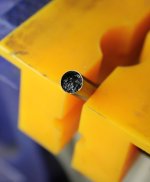T. O'Heir said:
Just the gas check and no bullet would sort of stand out when the thing was loaded into the mag. And if the powder was bad it would've been more than one.
I've had contaminated powder in a single case, before. You can contaminate a single powder charge without ruining an entire canister.
In my experience, it is generally caused by that
case being contaminated before being charged, or the base of a bullet being contaminated before seating.
Sucks, but it happens.
---
Unclenick, thanks for bringing up the reformulation. I knew it had happened, but I never remember. All of my IMR4895 is from 1998, or older. (Well, most of the H4895, too.

)
When I was experimenting with .22 WMR handloads, I became increasingly familiar with the fused clumps of yellowed unburned powder, with each new experiment. After a while, the sound of the report was enough to tell me whether I had low pressure with a stuck bullet, or low pressure with fused powder and a stuck bullet.
This one (below), however, was special. I was using a heavy weight bullet with a powder that I considered too slow for the application - H4895.
Several rounds fired prior to this one resulted in stuck bullets and fused clumps of yellow powder granules in the barrel. (I work up
really slowly with ridiculous things like handloaded .22 WMR, even if I still appear to be well under operating pressure and believe the charge will be heavily compressed before there's any chance of over-pressure).
But, this one....
This one launched the bullet at what I figured to be 1,200+ fps, and the powder never left the case. It fused in place. On top of that, it was jet black, glossy, and resembled something like Titegroup, more than H4895.
It's nothing terribly impressive. But it was an outlier and an oddity. ...Surprised me and caught me off guard.
It doesn't
look like it, but that's H4895.
The case rolled around on my bench for about 8 months, until I decided to give up on the .22 WMR. (There are better ways to waste money.)
When cleaning the bench one day, I decided to keep it as a reminder of WHY I stopped trying to handload for the cartridge. So I just put a drop of white glue on the powder to help stabilize it, should it ever decide to break up. That's what gives it the look of being sealed.

